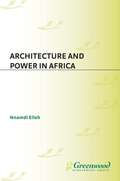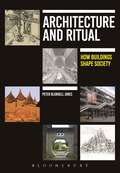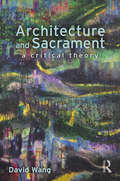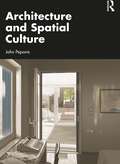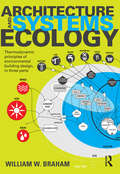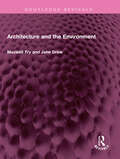- Table View
- List View
Architecture and Power in Africa (Non-ser.)
by Nnamdi EllehTwo of the most ambitious religious edifices of the 20th century are the Our Lady of Peace Basilica in the West African country of the Ivory Coast and the Hassan II Mosque in Morocco. Nnamdi Elleh not only provides a substantial architectural and pictorial analysis of the buildings themselves. Using these two buildings as case studies, he also investigates questions of national memory, urban form, architectural styles, concepts of democracy, social hierarchies as well as the elites who make the decisions to build Africa's post-independence monuments and capital cities. His book is an exciting synthesis of theoretical and empirical analysis that is bound to stimulate debate about the form and content of post-colonial identities in Africa.
Architecture and Resilience: Interdisciplinary Dialogues
by Kim Trogal Irena Bauman Ranald Lawrence Doina PetrescuResilience will be a defining quality of the twenty-first century. As we witness the increasingly turbulent effects of climate change, the multiple challenges of resource depletion and wage stagnation, we know that our current ways of living are not resilient. Our urban infrastructures, our buildings, our economies, our ways of managing and governing are still too tightly bound to models of unrestrained free-market growth, individualism and consumerism. Research has shown that the crises arising from climate change will become increasingly frequent and increasingly severe. It is also known that the effects of climate change are not evenly distributed across places and people, and neither are the resources needed to meet these challenges. We will need specific responses in place that engage with, and emerge from, citizens ourselves. This volume takes resilience as a transformative concept to ask where and what architecture might contribute. Bringing together cross-disciplinary perspectives from architecture, urban design, art, geography, building science and psychoanalysis, it aims to open up multiple perspectives of research, spatial strategies and projects that are testing how we can build local resilience in preparation for major societal challenges, defining the position of architecture in urban resilience discourse.
Architecture and Resilience: Interdisciplinary Dialogues
by Kim Trogal Irena Bauman Ranald Lawrence Doina PetrescuResilience will be a defining quality of the twenty-first century. As we witness the increasingly turbulent effects of climate change, the multiple challenges of resource depletion and wage stagnation, we know that our current ways of living are not resilient. Our urban infrastructures, our buildings, our economies, our ways of managing and governing are still too tightly bound to models of unrestrained free-market growth, individualism and consumerism. Research has shown that the crises arising from climate change will become increasingly frequent and increasingly severe. It is also known that the effects of climate change are not evenly distributed across places and people, and neither are the resources needed to meet these challenges. We will need specific responses in place that engage with, and emerge from, citizens ourselves. This volume takes resilience as a transformative concept to ask where and what architecture might contribute. Bringing together cross-disciplinary perspectives from architecture, urban design, art, geography, building science and psychoanalysis, it aims to open up multiple perspectives of research, spatial strategies and projects that are testing how we can build local resilience in preparation for major societal challenges, defining the position of architecture in urban resilience discourse.
Architecture and Retrenchment: Neoliberalization of the Swedish Model across Aesthetics and Space, 1968–1994
by Helena MattssonScholars in architectural and urban history have, over the last decade, been trying to come to terms with architecture's 'neoliberal turn' and its various impacts - from municipal policy to the artistic imagination. However most scholarship has focussed on generalizations, with very little work to date focussing on specific cases. Architecture and Retrenchment brings one such case to the fore – investigating the relation between architecture and the Swedish Model of the welfare state. It tracks the response of architecture to the gradual retrenchment and ultimate dismantling of the Swedish welfare state – which was, in its heyday, world-famous for its integration of architecture and the built environment into the welfare system. Ultimately, neoliberal economics prevailed, yet this book reveals how new architectural strategies and techniques were developed in order to protect the agency of architecture in the newly reorganised society of the 1980s and 1990s. Through eight in-depth case-studies, the book situates the often abstract, generalised discourse of neoliberalism and privatisation in specific architectural sites, and provides an original interpretation of how architecture, space, aesthetics, and politics converged at the end of the twentieth century.
Architecture and Retrenchment: Neoliberalization of the Swedish Model across Aesthetics and Space, 1968–1994
by Helena MattssonScholars in architectural and urban history have, over the last decade, been trying to come to terms with architecture's 'neoliberal turn' and its various impacts - from municipal policy to the artistic imagination. However most scholarship has focussed on generalizations, with very little work to date focussing on specific cases. Architecture and Retrenchment brings one such case to the fore – investigating the relation between architecture and the Swedish Model of the welfare state. It tracks the response of architecture to the gradual retrenchment and ultimate dismantling of the Swedish welfare state – which was, in its heyday, world-famous for its integration of architecture and the built environment into the welfare system. Ultimately, neoliberal economics prevailed, yet this book reveals how new architectural strategies and techniques were developed in order to protect the agency of architecture in the newly reorganised society of the 1980s and 1990s. Through eight in-depth case-studies, the book situates the often abstract, generalised discourse of neoliberalism and privatisation in specific architectural sites, and provides an original interpretation of how architecture, space, aesthetics, and politics converged at the end of the twentieth century.
Architecture and Revolution: Contemporary Perspectives on Central and Eastern Europe
by Neil LeachArchitecture and Revolution explores the consequences of the 1989 revolutions in Central and Eastern Europe from an architectural perspective. It presents new writings from a team of renowned architects, philosophers and cultural theorists from both the East and the West. They explore the questions over the built environment that now face architects, planners and politicians in the region. They examine the problems of buildings inherited from the communist era: some are environmentally inadequate, many were designed to serve a now redundant social programme and others carry the stigma of association with previous regimes. Contributors include: Daniel Libeskind, Bernard Tschumi, Laura Mulvey, Helene Cixous, Andrew Benjamin and Frederic Jameson.
Architecture and Revolution: Contemporary Perspectives on Central and Eastern Europe
by Neil LeachArchitecture and Revolution explores the consequences of the 1989 revolutions in Central and Eastern Europe from an architectural perspective. It presents new writings from a team of renowned architects, philosophers and cultural theorists from both the East and the West. They explore the questions over the built environment that now face architects, planners and politicians in the region. They examine the problems of buildings inherited from the communist era: some are environmentally inadequate, many were designed to serve a now redundant social programme and others carry the stigma of association with previous regimes. Contributors include: Daniel Libeskind, Bernard Tschumi, Laura Mulvey, Helene Cixous, Andrew Benjamin and Frederic Jameson.
Architecture and Ritual: How Buildings Shape Society
by Peter Blundell JonesArchitecture and Ritual explores how the varied rituals of everyday life are framed and defined in space by the buildings which we inhabit. It penetrates beyond traditional assumptions about architectural style, aesthetics and utility to deal with something more implicit: how buildings shape and reflect our experience in ways of which we remain unconscious.Whether designed to house a grand ceremony or provide shelter for a daily meal, all buildings coordinate and consolidate social relations by giving orientation and focus to the spatial practices of those who use them. Peter Blundell Jones investigates these connections between the social and the spatial, providing critical insights into the capacity for architecture to structure human ritual, from the grand and formal to the mundane. This is achieved through deep readings of individual pieces of architecture, each with a detailed description of its particular social setting and use. The case studies are drawn from throughout architectural history and from around the globe, each enabling a distinct theoretical theme to emerge, and showing how social conventions vary with time and place, as well as what they have in common. Case studies range from the Nuremberg Rally to the Centre Pompidou, and from the Palace of Westminster to Dogon dwellings in Africa and a Modernist hospital.In considering how all architecture has to mesh with the habits, beliefs, rituals and expectations of the society that created it, the book presents deep implications for our understanding of architectural history and theory. It also highlights the importance for architects of understanding how buildings frame social space before they prescribe new architectural designs of their own. The book ends with a recent example of user participation, showing how contemporary user interest and commitment to a building can be as strong as ever.
Architecture and Ritual: How Buildings Shape Society
by Peter Blundell JonesArchitecture and Ritual explores how the varied rituals of everyday life are framed and defined in space by the buildings which we inhabit. It penetrates beyond traditional assumptions about architectural style, aesthetics and utility to deal with something more implicit: how buildings shape and reflect our experience in ways of which we remain unconscious.Whether designed to house a grand ceremony or provide shelter for a daily meal, all buildings coordinate and consolidate social relations by giving orientation and focus to the spatial practices of those who use them. Peter Blundell Jones investigates these connections between the social and the spatial, providing critical insights into the capacity for architecture to structure human ritual, from the grand and formal to the mundane. This is achieved through deep readings of individual pieces of architecture, each with a detailed description of its particular social setting and use. The case studies are drawn from throughout architectural history and from around the globe, each enabling a distinct theoretical theme to emerge, and showing how social conventions vary with time and place, as well as what they have in common. Case studies range from the Nuremberg Rally to the Centre Pompidou, and from the Palace of Westminster to Dogon dwellings in Africa and a Modernist hospital.In considering how all architecture has to mesh with the habits, beliefs, rituals and expectations of the society that created it, the book presents deep implications for our understanding of architectural history and theory. It also highlights the importance for architects of understanding how buildings frame social space before they prescribe new architectural designs of their own. The book ends with a recent example of user participation, showing how contemporary user interest and commitment to a building can be as strong as ever.
Architecture and Sacrament: A Critical Theory
by David WangDavid Wang’s Architecture and Sacrament considers architectural theory from a Christian theological perspective, specifically, the analogy of being (analogia entis). The book tracks social and cultural reasons why the theological literature tends to be separate from contemporary architecture theory. Wang argues that retrieval of the sacramental outlook embedded within the analogy of being, which informed centuries of art and architecture in the West, can shed light on current architectural issues such as "big box stores," the environmental crisis and the loss of sense of community. The book critiques the materialist basis of current architectural discourse, subsumed largely under the banner of critical theory. This volume on how European ideas inform architectural theory complements Wang’s previous book, A Philosophy of Chinese Architecture: Past, Present, Future, and will appeal to architecture students and academics, as well as those grappling with the philosophical moorings of all built environments.
Architecture and Sacrament: A Critical Theory
by David WangDavid Wang’s Architecture and Sacrament considers architectural theory from a Christian theological perspective, specifically, the analogy of being (analogia entis). The book tracks social and cultural reasons why the theological literature tends to be separate from contemporary architecture theory. Wang argues that retrieval of the sacramental outlook embedded within the analogy of being, which informed centuries of art and architecture in the West, can shed light on current architectural issues such as "big box stores," the environmental crisis and the loss of sense of community. The book critiques the materialist basis of current architectural discourse, subsumed largely under the banner of critical theory. This volume on how European ideas inform architectural theory complements Wang’s previous book, A Philosophy of Chinese Architecture: Past, Present, Future, and will appeal to architecture students and academics, as well as those grappling with the philosophical moorings of all built environments.
Architecture and Science-Fiction Film: Philip K. Dick and the Spectacle of Home (Ashgate Studies in Architecture)
by David T. FortinThe home is one of our most enduring human paradoxes and is brought to light tellingly in science-fiction (SF) writing and film. However, while similarities and crossovers between architecture and SF have proliferated throughout the past century, the home is often overshadowed by the spectacle of 'otherness'. The study of the familiar (home) within the alien (SF) creates a unique cultural lens through which to reflect on our current architectural condition. SF has always been linked with alienation; however, the conditions of such alienation, and hence notions of home, have evidently changed. There is often a perceived comprehension of the familiar that atrophies the inquisitive and interpretive processes commonly activated when confronting the unfamiliar. Thus, by utilizing the estranging qualities of SF to look at a concept inherently linked to its perceived opposite - the home - a unique critical analysis with particular relevance for contemporary architecture is made possible.
Architecture and Science-Fiction Film: Philip K. Dick and the Spectacle of Home (Ashgate Studies in Architecture)
by David T. FortinThe home is one of our most enduring human paradoxes and is brought to light tellingly in science-fiction (SF) writing and film. However, while similarities and crossovers between architecture and SF have proliferated throughout the past century, the home is often overshadowed by the spectacle of 'otherness'. The study of the familiar (home) within the alien (SF) creates a unique cultural lens through which to reflect on our current architectural condition. SF has always been linked with alienation; however, the conditions of such alienation, and hence notions of home, have evidently changed. There is often a perceived comprehension of the familiar that atrophies the inquisitive and interpretive processes commonly activated when confronting the unfamiliar. Thus, by utilizing the estranging qualities of SF to look at a concept inherently linked to its perceived opposite - the home - a unique critical analysis with particular relevance for contemporary architecture is made possible.
Architecture and Silence (Routledge Research in Architecture)
by Christos P. KakalisThis book explores the role of silence in how we design, present and experi-ence architecture. Grounded in phenomenological theory, the book builds on historical, theoretical and practical approaches to examine silence as a methodological tool of architectural research and unravel the experiential qualities of the design process. Distinct from an entirely soundless experience, silence is proposed as a material condition organically incorporated into the built and natural landscape. Kakalis argues that, either human or atmospheric, silence is a condition of waiting for a sound to be born or a new spatio-temporal event to emerge. In silence, therefore, we are attentive and attuned to the atmos-phere of a place. The book unpacks a series of stories of silence in religious topographies, urban landscapes, film and theatre productions and architec-tural education with contributed chapters and interviews with Jeff Malpas and Alberto Pérez-Gómez. Aimed at postgraduate students, scholars and researchers in architectural theory, it shows how performative and atmospheric qualities of silence can build a new understanding of architectural experience.
Architecture and Silence (Routledge Research in Architecture)
by Christos P. KakalisThis book explores the role of silence in how we design, present and experi-ence architecture. Grounded in phenomenological theory, the book builds on historical, theoretical and practical approaches to examine silence as a methodological tool of architectural research and unravel the experiential qualities of the design process. Distinct from an entirely soundless experience, silence is proposed as a material condition organically incorporated into the built and natural landscape. Kakalis argues that, either human or atmospheric, silence is a condition of waiting for a sound to be born or a new spatio-temporal event to emerge. In silence, therefore, we are attentive and attuned to the atmos-phere of a place. The book unpacks a series of stories of silence in religious topographies, urban landscapes, film and theatre productions and architec-tural education with contributed chapters and interviews with Jeff Malpas and Alberto Pérez-Gómez. Aimed at postgraduate students, scholars and researchers in architectural theory, it shows how performative and atmospheric qualities of silence can build a new understanding of architectural experience.
Architecture and Spatial Culture
by John PeponisBuilt space supports our daily habits and our membership of communities, organizations, institutions, or social formations. Architecture and Spatial Culture argues that architecture matters because it makes the settings of our life intelligible, so that we can sustain or creatively transform them.As technological and social innovations allow us to overcome spatial constraints to communication, cooperation, and exchange, so the architecture of embodied experience reflects independent cultural choices and human values. The analysis of a wealth of examples, from urban environments to workplaces and museums, shows that built space functions pedagogically, inducing us to specific ways of seeing, understanding, and feeling, and supporting distinct patterns of cooperation and life in common.Architecture and Spatial Culture is about the principles that underpin the design and inhabitation of space. It also serves as an introduction to Space Syntax, a descriptive theory used to model the human functions of layouts. Thus, it addresses architects, students of architecture and all those working in disciplines that engage the design of the built environment and its social effects.
Architecture and Spatial Culture
by John PeponisBuilt space supports our daily habits and our membership of communities, organizations, institutions, or social formations. Architecture and Spatial Culture argues that architecture matters because it makes the settings of our life intelligible, so that we can sustain or creatively transform them.As technological and social innovations allow us to overcome spatial constraints to communication, cooperation, and exchange, so the architecture of embodied experience reflects independent cultural choices and human values. The analysis of a wealth of examples, from urban environments to workplaces and museums, shows that built space functions pedagogically, inducing us to specific ways of seeing, understanding, and feeling, and supporting distinct patterns of cooperation and life in common.Architecture and Spatial Culture is about the principles that underpin the design and inhabitation of space. It also serves as an introduction to Space Syntax, a descriptive theory used to model the human functions of layouts. Thus, it addresses architects, students of architecture and all those working in disciplines that engage the design of the built environment and its social effects.
Architecture and Spectacle: A Critique
by Gevork HartoonianFocusing on six leading contemporary architects: Peter Eisenman, Frank Gehry, Bernard Tschumi, Zaha Hadid, Rem Koolhaas and Steven Holl, this book puts forward a unique and insightful analysis of "neo-avant-garde" architecture. It discusses the spectacle and excess which permeates contemporary architecture in reference to the present aesthetic tendency for image making, but does so by applying the tectonic of theatricality discussed by the 19th-century German architect Gottfried Semper. In doing so, it breaks new ground by opening up a dialogue between the study of the past and the design of the present. The work of each discussed architect is seen as addressing a historiographical problem. To this end, and this is the second important aspect of this book, the chosen buildings are discussed in terms of the thematic of the culture of building (the tectonic of column and wall for example) rather the formal, and this through a discussion that is informed by the latest available theories. Having set the aesthetic implication of the processes of the digitalization of architecture, the book's conclusion highlights "strategies" by which architecture might postpone the full consequences of digitalization, and thus the becoming of architecture as ornament on its own right.
Architecture and Spectacle: A Critique
by Gevork HartoonianFocusing on six leading contemporary architects: Peter Eisenman, Frank Gehry, Bernard Tschumi, Zaha Hadid, Rem Koolhaas and Steven Holl, this book puts forward a unique and insightful analysis of "neo-avant-garde" architecture. It discusses the spectacle and excess which permeates contemporary architecture in reference to the present aesthetic tendency for image making, but does so by applying the tectonic of theatricality discussed by the 19th-century German architect Gottfried Semper. In doing so, it breaks new ground by opening up a dialogue between the study of the past and the design of the present. The work of each discussed architect is seen as addressing a historiographical problem. To this end, and this is the second important aspect of this book, the chosen buildings are discussed in terms of the thematic of the culture of building (the tectonic of column and wall for example) rather the formal, and this through a discussion that is informed by the latest available theories. Having set the aesthetic implication of the processes of the digitalization of architecture, the book's conclusion highlights "strategies" by which architecture might postpone the full consequences of digitalization, and thus the becoming of architecture as ornament on its own right.
Architecture and Systems Ecology: Thermodynamic Principles of Environmental Building Design, in three parts
by William W. BrahamModern buildings are both wasteful machines that can be made more efficient and instruments of the massive, metropolitan system engendered by the power of high-quality fuels. A comprehensive method of environmental design must reconcile the techniques of efficient building design with the radical urban and economic reorganization that we face. Over the coming century, we will be challenged to return to the renewable resource base of the eighteenth-century city with the knowledge, technologies, and expectations of the twenty-first-century metropolis. This book explores the architectural implications of systems ecology, which extends the principles of thermodynamics from the nineteenth-century focus on more efficient machinery to the contemporary concern with the resilient self-organization of ecosystems. Written with enough technical material to explain the methods, it does not include in-text equations or calculations, relying instead on the energy system diagrams to convey the argument. Architecture and Systems Ecology has minimal technical jargon and an emphasis on intelligible design conclusions, making it suitable for architecture students and professionals who are engaged with the fundamental issues faced by sustainable design. The energy systems language provides a holistic context for the many kinds of performance already evaluated in architecture—from energy use to material selection and even the choice of building style. It establishes the foundation for environmental principles of design that embrace the full complexity of our current situation. Architecture succeeds best when it helps shape, accommodate, and represent new ways of living together.
Architecture and Systems Ecology: Thermodynamic Principles of Environmental Building Design, in three parts
by William W. BrahamModern buildings are both wasteful machines that can be made more efficient and instruments of the massive, metropolitan system engendered by the power of high-quality fuels. A comprehensive method of environmental design must reconcile the techniques of efficient building design with the radical urban and economic reorganization that we face. Over the coming century, we will be challenged to return to the renewable resource base of the eighteenth-century city with the knowledge, technologies, and expectations of the twenty-first-century metropolis. This book explores the architectural implications of systems ecology, which extends the principles of thermodynamics from the nineteenth-century focus on more efficient machinery to the contemporary concern with the resilient self-organization of ecosystems. Written with enough technical material to explain the methods, it does not include in-text equations or calculations, relying instead on the energy system diagrams to convey the argument. Architecture and Systems Ecology has minimal technical jargon and an emphasis on intelligible design conclusions, making it suitable for architecture students and professionals who are engaged with the fundamental issues faced by sustainable design. The energy systems language provides a holistic context for the many kinds of performance already evaluated in architecture—from energy use to material selection and even the choice of building style. It establishes the foundation for environmental principles of design that embrace the full complexity of our current situation. Architecture succeeds best when it helps shape, accommodate, and represent new ways of living together.
Architecture and the Body, Science and Culture (Routledge Research in Architecture)
by Kim SextonThe relationship of architecture to the human body is a centuries-long and complex one, but not always symmetrical. This book opens a space for historians of the visual arts, archaeologists, architects, and digital humanities professionals to reflect upon embodiment, spatiality, science, and architecture in premodern and modern cultural contexts. Architecture and the Body, Science and Culture poses one overarching question: How does a period’s understanding of bodies as objects of science impinge upon architectural thought and design? The answers are sophisticated, interdisciplinary explorations of theory, technology, symbolism, medicine, violence, psychology, deformity, and salvation, and they have unexpected and fascinating implications for architectural design and history. The new research published in this volume reinvigorates the Western survey-style trajectory from Archaic Greece to post‐war Europe with scientifically‐framed, body‐centred provocations. By adding the third factor—science—to the architecture and body equation, this book presents a nuanced appreciation for architectural creativity and its embeddedness in other sets of social, institutional and political relationships. In so doing, it spatializes body theory and ties it to the experience of the built environment in ways that disturb traditional boundaries between the architectural container and the corporeally contained.
Architecture and the Body, Science and Culture (Routledge Research in Architecture)
by Kim SextonThe relationship of architecture to the human body is a centuries-long and complex one, but not always symmetrical. This book opens a space for historians of the visual arts, archaeologists, architects, and digital humanities professionals to reflect upon embodiment, spatiality, science, and architecture in premodern and modern cultural contexts. Architecture and the Body, Science and Culture poses one overarching question: How does a period’s understanding of bodies as objects of science impinge upon architectural thought and design? The answers are sophisticated, interdisciplinary explorations of theory, technology, symbolism, medicine, violence, psychology, deformity, and salvation, and they have unexpected and fascinating implications for architectural design and history. The new research published in this volume reinvigorates the Western survey-style trajectory from Archaic Greece to post‐war Europe with scientifically‐framed, body‐centred provocations. By adding the third factor—science—to the architecture and body equation, this book presents a nuanced appreciation for architectural creativity and its embeddedness in other sets of social, institutional and political relationships. In so doing, it spatializes body theory and ties it to the experience of the built environment in ways that disturb traditional boundaries between the architectural container and the corporeally contained.
Architecture and the Environment (Routledge Revivals)
by Maxwell Fry Jane DrewFirst published in 1976 Architecture and the Environment is based on the authors very successful Architecture of Children. The original book has been completely revised and new illustrations have been specially drawn. This book gives a comprehensive account of the role of architecture in the environment of a constantly developing world. It traces the history of building from its most primitive origins to the complex architecture of the current times. The book takes as a starting- point ideas that will be familiar to all its readers, then leads them on to an examination of the attitudes and approaches of architects and planners, so that they can follow the creative process step by step. The style of the book is direct and very readable, with a minimum of technological language and will be useful for general readers interested in architecture.
Architecture and the Environment (Routledge Revivals)
by Maxwell Fry Jane DrewFirst published in 1976 Architecture and the Environment is based on the authors very successful Architecture of Children. The original book has been completely revised and new illustrations have been specially drawn. This book gives a comprehensive account of the role of architecture in the environment of a constantly developing world. It traces the history of building from its most primitive origins to the complex architecture of the current times. The book takes as a starting- point ideas that will be familiar to all its readers, then leads them on to an examination of the attitudes and approaches of architects and planners, so that they can follow the creative process step by step. The style of the book is direct and very readable, with a minimum of technological language and will be useful for general readers interested in architecture.
